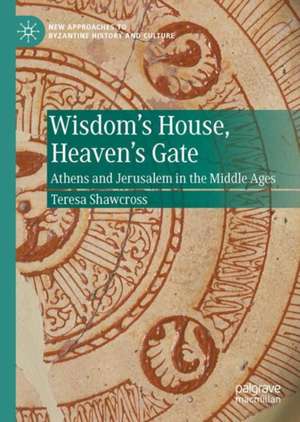Wisdom's House, Heaven's Gate: Athens and Jerusalem in the Middle Ages: New Approaches to Byzantine History and Culture
Autor Teresa Shawcrossen Limba Engleză Hardback – 16 oct 2024
Din seria New Approaches to Byzantine History and Culture
- 18%
 Preț: 722.43 lei
Preț: 722.43 lei - 15%
 Preț: 693.57 lei
Preț: 693.57 lei - 18%
 Preț: 791.57 lei
Preț: 791.57 lei - 15%
 Preț: 530.42 lei
Preț: 530.42 lei - 15%
 Preț: 705.34 lei
Preț: 705.34 lei - 15%
 Preț: 532.56 lei
Preț: 532.56 lei - 15%
 Preț: 697.82 lei
Preț: 697.82 lei - 18%
 Preț: 891.96 lei
Preț: 891.96 lei - 9%
 Preț: 762.76 lei
Preț: 762.76 lei - 18%
 Preț: 722.89 lei
Preț: 722.89 lei - 18%
 Preț: 721.63 lei
Preț: 721.63 lei - 18%
 Preț: 724.63 lei
Preț: 724.63 lei - 18%
 Preț: 725.75 lei
Preț: 725.75 lei - 18%
 Preț: 721.01 lei
Preț: 721.01 lei - 18%
 Preț: 781.00 lei
Preț: 781.00 lei - 15%
 Preț: 691.91 lei
Preț: 691.91 lei - 18%
 Preț: 727.48 lei
Preț: 727.48 lei - 18%
 Preț: 732.70 lei
Preț: 732.70 lei - 15%
 Preț: 637.13 lei
Preț: 637.13 lei - 18%
 Preț: 735.84 lei
Preț: 735.84 lei - 18%
 Preț: 953.65 lei
Preț: 953.65 lei - 18%
 Preț: 785.55 lei
Preț: 785.55 lei
Preț: 738.69 lei
Preț vechi: 900.84 lei
-18% Nou
Puncte Express: 1108
Preț estimativ în valută:
141.39€ • 153.64$ • 118.85£
141.39€ • 153.64$ • 118.85£
Carte tipărită la comandă
Livrare economică 21 aprilie-05 mai
Preluare comenzi: 021 569.72.76
Specificații
ISBN-13: 9783031352621
ISBN-10: 3031352629
Ilustrații: XXXVII, 474 p. 73 illus., 62 illus. in color.
Dimensiuni: 148 x 210 mm
Greutate: 0.76 kg
Ediția:1st ed. 2024
Editura: Springer Nature Switzerland
Colecția Palgrave Macmillan
Seria New Approaches to Byzantine History and Culture
Locul publicării:Cham, Switzerland
ISBN-10: 3031352629
Ilustrații: XXXVII, 474 p. 73 illus., 62 illus. in color.
Dimensiuni: 148 x 210 mm
Greutate: 0.76 kg
Ediția:1st ed. 2024
Editura: Springer Nature Switzerland
Colecția Palgrave Macmillan
Seria New Approaches to Byzantine History and Culture
Locul publicării:Cham, Switzerland
Cuprins
Chapter 1. Introduction: Athens and Jerusalem—Reframing the Question.- Chapter 2. The Parthenon from Temple to Church.- Chapter 3. A Miracle of Heavenly Fire.- Chapter 4. The Relocation of Jerusalem.- Chapt 5. The Light of Hellenism in Empire and Caliphate.- Chapter 6. Wisdom: Lady of the Temple, Lady of the Red Thread.- Chapter 7. Conclusion: The City on a Hill./
Notă biografică
Teresa Shawcross is Associate Professor of History and Hellenic Studies at Princeton University, USA and a Senior Member of Robinson College, University of Cambridge, UK. She has previously published The Chronicle of Morea: Historiography in Crusader Greece and Reading in the Byzantine Empire and Beyond.
Textul de pe ultima copertă
Taking as its starting point an investigation into the physical topography and symbolism of the two cities of Athens and Jerusalem, this book offers a cultural history of the rival superpowers—the Byzantine Empire and Fatimid Caliphate—that between them dominated the Mediterranean world during the Central Middle Ages. It shows that the destruction of the Church of the Holy Sepulchre in Jerusalem on the orders of al-Hakim punctuated a century of heightened interaction resulting from changing patterns of warfare, trade and pilgrimage. Resettlement of both Christians and Muslims from Syria-Palestine in Asia Minor and the Balkans introduced these migrants’ host culture to new forms of religious and artistic expression. In Hellas, a flurry of building projects reinvented Athens as a New Jerusalem and the Parthenon as a New Temple. The Acropolis became famous for its miraculous lamp and elaborate liturgy. The clergy who performed the sacred mysteries justified them with reference to concepts of hierarchy, illumination and divinisation. These concepts were derived from a philosophical tradition over whose ownership the two superpowers competed. The resulting political theology was the creation of male intellectuals, but female patrons and worshippers also had an impact.
Caracteristici
Offers the first cultural and intellectual history of the entanglement of the Byzantine Empire and the Fatimid Caliphate Poses nuanced discussions of the symbolism of ancient Athens and Jerusalem outside western Europe during the Middle Ages Gives an in-depth analysis of textual, artistic and archaeological evidence from different social and gendered contexts
